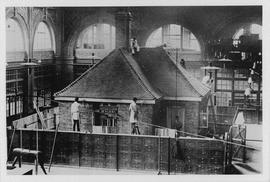Área de identidad
Código de referencia
Título
Fecha(s)
- 1902-1979 (Creación)
Nivel de descripción
Volumen y soporte
5 boxes
Área de contexto
Nombre del productor
Historia administrativa
The London County Council School of Building was opened on 26th February 1904 with Mr H W Richards as Principal to provide a specialist training college for the large number of building workers in Camberwell and Lambeth. The Lambeth Polytechnic building in Ferndale Road, Brixton was renovated to contain workshops for painting and decorating, carpentry and joinery and a drawing office. When it first opened, 643 students enrolled on classes covering stone carving, plasterers' modelling, drawing, chemistry and physics of building materials, land surveying and levelling. The School soon gained a world-wide reputation as a centre of excellence in the fields of town planning, building technology, estate management and building architecture.
In 1906 a school of architecture was added which was organised by Professor Beresford Pite of the Royal Academy of Art. Demand for courses increased rapidly so that in 1908 the School added a Junior Day Technical College for Boys and then a Senior Day Technical School as well as a new extension in 1909. In 1910 five-year courses were introduced in all trade subjects, followed in 1911 by a four year course in reinforced concrete and in 1912 a course in structural engineering all examined by the City and Guilds of London Institute. In 1921 Mr A R Sage became Principal (the Sage Medallion was in the possession of the former Vauxhall College). In 1922, Sir Robert Blair (LCC Education Officer) wrote, 'the Brixton School is easily the first and most complete school of building in the world'. In 1927 until 1943 Mr F E Drury became Principal. The Board of Education classified the School as a College of Further Education in 1928 and the following year a three year day course was introduced leading to the Ordinary and Higher National Diploma in Building or the Intermediate Examination of the Royal Institute of British Architects or the Chartered Surveyors Institute.
In 1943 it became the Brixton School of Building, in March 1945 Mr D A G Reid CBE became Principal and after the Second World War the School rapidly expanded so that by 1949 the number of full time students exceeded 400, studying courses in architecture, surveying and structural engineering. In 1956 Brixton was designated a regional college, and the governors decided not to concentrate on work at higher levels, but to retain its craft work and lower level teaching. Under the government's policy for higher education, given in the White Paper 'A Plan for Polytechnics and Other Colleges', published in 1966, the higher level studies at Brixton would have to be continued within a new institution based on the polytechnic model. Brixton School of Building became part of the Polytechnic of the South Bank in 1970, along with the Borough Polytechnic, City of Westminster College and the National College for Heating, Ventilating, Refrigeration and Fan Engineering. The last Principal wrote, '1970 marked the end of the beginning; the School of Building had faithfully served many days and generations of students but to the work it was doing there is no end'.
Five of the six departments from Brixton became the new Polytechnic's Faculty of Construction, Technology and Design. The sixth department, along with some work from other departments formed the Vauxhall College of Further Education. The Faculty moved into the new purpose-designed Wandsworth Road building, on the Wandsworth Road, during the summer of 1973, a decade after the first draft schedule of accommodation was made. The building was officially opened on 17 April 1975 by Anthony Crosland MP. The Faculty became the largest and most comprehensive Built Environment faculty in Europe covering subjects such as Property Development, Waste Management and Architecture. In the summer of 2003 the Wandsworth Road building was sold by London South Bank University and students and staff transferred back to the University's main Southwark campus to form the Faculty of Engineering, Science and the Built Environment.
Institución archivística
Historia archivística
Origen del ingreso o transferencia
Área de contenido y estructura
Alcance y contenido
Contains the records of Brixton School of Building. The collection has been arranged into the following categories:
BSB/1 Works in Converting the Baths in Ferndale Road into a Technical Institute, 1902;
BSB/2 Prospectuses, 1904-1971;
BSB/3 Historical Publications, 1955-1979;
BSB/4 Magazines, 1950-1963;
BSB/5 Distribution of Prizes and Exhibition Work, 1948-1960;
BSB/6 Syllabuses, Course Notes and Examination Papers, 1953-1970;
BSB/7 Administration, 1960s;
BSB/8 Professional Publications, 1963-1977.
BSB/9 Photographs, c.1910-1930s
Valorización, destrucción y programación
Acumulaciones
Sistema de arreglo
Área de condiciones de acceso y uso
Condiciones de acceso
Open except for records restricted under the Data Protection Act or the Freedom of Information Act. Please contact the University Archivist for details. 24 hours notice is required for research visits.
Condiciones
Idioma del material
- inglés
Escritura del material
Notas sobre las lenguas y escrituras
Características físicas y requisitos técnicos
Instrumentos de descripción
Área de materiales relacionados
Existencia y localización de originales
Existencia y localización de copias
Unidades de descripción relacionadas
Records relating to the School of Building can also be found at London Metropolitan Archives, refs:
LCC/EO/HFE/04/017-020
LCC/EO/HFE/04/178-179
LCC/EO/HFE/04/133-135
LCC/EO/HFE/12/6
An autobiographical typescript by Gertrude Leverkus, governor of the school, is held by the Women's Library at the London School of Economics, ref: 7GLE.
Área de notas
Identificador/es alternativo(os)
Puntos de acceso
Puntos de acceso por materia
Puntos de acceso por lugar
Puntos de acceso por autoridad
- Brixton School of Building (Materia)
Tipo de puntos de acceso
Área de control de la descripción
Identificador de la descripción
Identificador de la institución
Reglas y/o convenciones usadas
Estado de elaboración
Nivel de detalle
Fechas de creación revisión eliminación
09/06/2020
Idioma(s)
Escritura(s)
Fuentes
Nota del archivista
London South Bank University Archives Centre














